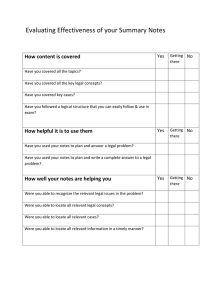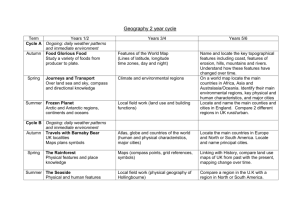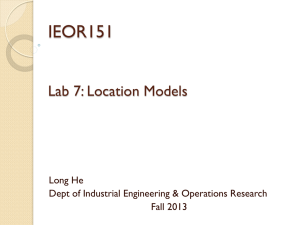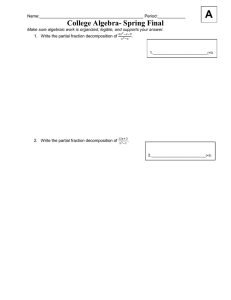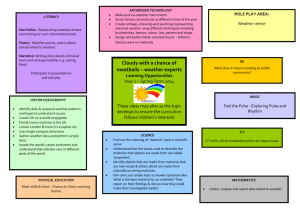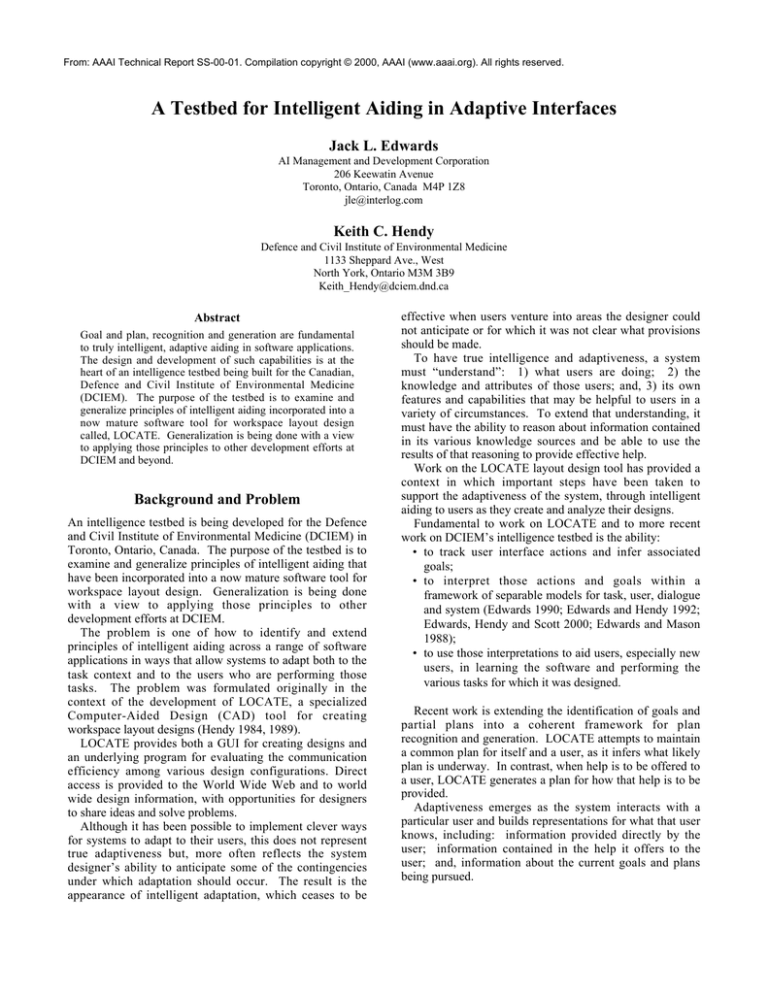
From: AAAI Technical Report SS-00-01. Compilation copyright © 2000, AAAI (www.aaai.org). All rights reserved.
A Testbed for Intelligent Aiding in Adaptive Interfaces
Jack L. Edwards
AI Management and Development Corporation
206 Keewatin Avenue
Toronto, Ontario, Canada M4P 1Z8
jle@interlog.com
Keith C. Hendy
Defence and Civil Institute of Environmental Medicine
1133 Sheppard Ave., West
North York, Ontario M3M 3B9
Keith_Hendy@dciem.dnd.ca
Abstract
Goal and plan, recognition and generation are fundamental
to truly intelligent, adaptive aiding in software applications.
The design and development of such capabilities is at the
heart of an intelligence testbed being built for the Canadian,
Defence and Civil Institute of Environmental Medicine
(DCIEM). The purpose of the testbed is to examine and
generalize principles of intelligent aiding incorporated into a
now mature software tool for workspace layout design
called, LOCATE. Generalization is being done with a view
to applying those principles to other development efforts at
DCIEM and beyond.
Background and Problem
An intelligence testbed is being developed for the Defence
and Civil Institute of Environmental Medicine (DCIEM) in
Toronto, Ontario, Canada. The purpose of the testbed is to
examine and generalize principles of intelligent aiding that
have been incorporated into a now mature software tool for
workspace layout design. Generalization is being done
with a view to applying those principles to other
development efforts at DCIEM.
The problem is one of how to identify and extend
principles of intelligent aiding across a range of software
applications in ways that allow systems to adapt both to the
task context and to the users who are performing those
tasks. The problem was formulated originally in the
context of the development of LOCATE, a specialized
Computer-Aided Design (CAD) tool for creating
workspace layout designs (Hendy 1984, 1989).
LOCATE provides both a GUI for creating designs and
an underlying program for evaluating the communication
efficiency among various design configurations. Direct
access is provided to the World Wide Web and to world
wide design information, with opportunities for designers
to share ideas and solve problems.
Although it has been possible to implement clever ways
for systems to adapt to their users, this does not represent
true adaptiveness but, more often reflects the system
designer’s ability to anticipate some of the contingencies
under which adaptation should occur. The result is the
appearance of intelligent adaptation, which ceases to be
effective when users venture into areas the designer could
not anticipate or for which it was not clear what provisions
should be made.
To have true intelligence and adaptiveness, a system
must “understand”: 1) what users are doing; 2) the
knowledge and attributes of those users; and, 3) its own
features and capabilities that may be helpful to users in a
variety of circumstances. To extend that understanding, it
must have the ability to reason about information contained
in its various knowledge sources and be able to use the
results of that reasoning to provide effective help.
Work on the LOCATE layout design tool has provided a
context in which important steps have been taken to
support the adaptiveness of the system, through intelligent
aiding to users as they create and analyze their designs.
Fundamental to work on LOCATE and to more recent
work on DCIEM’s intelligence testbed is the ability:
• to track user interface actions and infer associated
goals;
• to interpret those actions and goals within a
framework of separable models for task, user, dialogue
and system (Edwards 1990; Edwards and Hendy 1992;
Edwards, Hendy and Scott 2000; Edwards and Mason
1988);
• to use those interpretations to aid users, especially new
users, in learning the software and performing the
various tasks for which it was designed.
Recent work is extending the identification of goals and
partial plans into a coherent framework for plan
recognition and generation. LOCATE attempts to maintain
a common plan for itself and a user, as it infers what likely
plan is underway. In contrast, when help is to be offered to
a user, LOCATE generates a plan for how that help is to be
provided.
Adaptiveness emerges as the system interacts with a
particular user and builds representations for what that user
knows, including: information provided directly by the
user; information contained in the help it offers to the
user; and, information about the current goals and plans
being pursued.
LOCATE’s Models
Actions and goals related to the current task are placed into
a Task Model and displayed in a Task Model Window.
As task goals are satisfied or abandoned, they are moved
into an Action and Goal History that provides an audit trail
of what has been done.
LOCATE maintains a User Model, displaying
information about the user in its User Model Window.
Information in that window reflects LOCATE’s beliefs
about who the user is, some of his or her preferences and
what the user currently knows about LOCATE’s features.
LOCATE tracks user activities, in part to determine
whether the user is employing the most efficient way of
performing some task. If she is not, LOCATE provides
advice about how she can make more efficient use of the
software.
Finally, LOCATE maintains a System (Self) Model as a
way of representing its own features and capabilities and
how they might help users perform their tasks.
When a user wants help, she can choose “Smart Help”
from the Help Menu. A window is displayed that allows
her to inquire how some activity can be performed, e.g.,
“how to print.” LOCATE searches its knowledge base and
returns a set of possibilities in the form of goals related to
that activity and plans for how to achieve each. For
example, the goals returned for “how to print’ include:
• how to print a design;
• how to print a cost function;
• how to print a color cost display.
The user chooses the appropriate goal and LOCATE
displays a plan for accomplishing it in another portion of
the window.
At the same time help is being provided, LOCATE’s
System Model is updated and information is displayed in a
System Model Window. That information includes the
user’s query and any conclusions about how LOCATE has
determined it can help the user perform the requested
activity.
In future, LOCATE will offer to execute part or all of a
plan for achieving a user’s goal. By examining the user’s
history, LOCATE will be able to determine if a user
always, or most often, asks it to execute a given plan, and,
if so. will suggest that it be allowed to perform that as a
default function.
Feedback for Adaptation
LOCATE acquires information (feedback) about the
current task and user in three ways:
• from information provided directly to the system by
the user;
• from help and other information provided to the user
by the system;
• by tracking user actions at the interface and
interpreting them in terms of the user’s ongoing task.
These three sources of information are the ways
LOCATE “understands” the knowledge and capabilities a
user possesses and what the user is doing at the moment.
That knowledge is used to adapt LOCATE’s help to the
current context of user knowledge and action.
LOCATE initiates help under a variety of circumstances
including, for example, when it detects what are called,
“non-responsive” actions.
Non-responsive actions are ones that produce no
functional response by the system other than perhaps an
audio signal to indicate the fact.
A number of actions qualify as non-responsive actions
including: clicking on a ruler in the LOCATE Design
Window; clicking on a dimmed button or menu item;
double-clicking on a communication link between two
workstations; double-clicking a workstation’s rotation
arrow; and, attempting to resize a Source/Receiver (S/R)
Node.
A number of possible implications to these nonresponsive actions give direction to the kind of adaptive
aiding a system might offer. Two such implications are
that:
• the user has a clear goal in mind and is guessing at the
interface action that will achieve that goal;
• the user is responding to the presence of an unfamiliar
object by using standard action methods on the object
to see their effects.
In both cases, LOCATE first informs the user that his
action produces no task-related response by the system.
Next, it allows the user to identify the goal he had in mind
when he performed that action, by displaying a selectable
set of possibilities. Finally, it presents a plan for achieving
that goal if it and its plan recipe are stored in LOCATE’s
plan library.
Other goals presented as possibilities for the user’s
intended goal serve as opportunities for incidental learning,
if the user chooses to select them and examine their
associated plans.
As a consequence of providing help of this kind,
LOCATE is able to infer that the user now knows:
• that this action produces no task-related response by
the system;
• how to achieve his intended goal, i.e., the goal he had
in mind when he performed the non-responsive action.
Adaptive aspects of this kind of aiding follow from
LOCATE’s ability to determine whether a particular user
received help of this kind on a prior occasion.
After providing help about a specific non-responsive
action, if the user performs that action again at some later
time, LOCATE will assume he knows it will not produce
any task-related response. Under that circumstance, a
standard audio beep should be a sufficient reminder.
If the user performs the same action on several
subsequent occasions, LOCATE will see it as a
“contradictory action,” that is, an action that contradicts
LOCATE’s beliefs about what the user should know. In
that case, help is offered with the goal of clarifying the
apparent contradiction.
testbed and on the design and development of the
LOCATE Workspace Layout Tool was conducted under
several prior contracts.
Feedback Effects on System Performance
References
Feedback obtained directly from the user is currently quite
limited in LOCATE and has minimal effects on system
performance. Such information is obtained when the user
tells LOCATE who he is, what preferences he has with
respect to features of the software and whether he wishes
LOCATE to track his activities and offer help.
The decision to provide help to a user, the specific help
to be provided and how that help is realized in the
interface, all have minimal effects on system performance.
High priority help, resulting in the display of an Alert, is
the most intrusive kind of help and appears most frequently
with new users who are learning the software.
When used, it influences overall system performance
because of the interruption of the flow of user activity.
The trade-off for this decrement in overall performance is
that such help is believed to result in more effective use of
LOCATE in the long run and in fewer errors in task
performance.
Moderate priority help results in unobtrusive displays of
graphical indicators (“light bulbs”) that some help is in the
offing. Low priority help is only offered when its priority
changes through circumstances that add cumulatively to
that priority. Neither of these types of help currently
impact system performance to any significant degree.
Broadbent, G. (1988). Design in architecture. London:
David Fulton Publishers.
Edwards, J. L. (1990). Proposed architecture for
SDBMS–2. Report prepared for the Defence and
Civil Institute of Environmental Medicine (DCIEM)
by Artificial Intelligence Management and
Development Corporation.
Toronto, Ontario,
Canada.
Edwards, J. L., & Hendy, K. (1992). Development and
validation of user models in an air traffic control
simulation.
Paper presented at the Second
International Workshop on User Modeling.
International Conference and Research Center for
Computer Science (IBFI), Dagstuhl Castle, Germany,
August 10-13, 1992.
Edwards, J. L., Hendy, K., & Scott (2000). A Testbed for
Adaptive Aiding Using the LOCATE Workspace
Layout Tool. Paper submitted for a Special Issue on
Deployed Systems to the Journal of User Modeling
and User Adapted Interaction.
Edwards, J. L., & Mason, J. A.(1988). Toward intelligent
dialogue with ISIS. International Journal of ManMachine Studies, 28, 309-342.
Hendy, K. C. (1984). 'Locate': A program for computeraided workspace layout. Master's Thesis, Department
of Electrical Engineering, Monash University,
Clayton, Victoria, Australia.
Hendy, K. C. (1989). A Model for Human-MachineHuman Interaction in Workspace Layout Problems.
Human Factors, 31(5), 593-610.
Hendy, K. C., Edwards, J. L., Beevis, D., & Hamburger, T.
(2000). Analyzing advanced concepts for operations
room layouts. Proceedings of the IEA/HFES 2000
Congress. San Diego, CA, July 30-August 4, 2000.
Powers, W. T. (1973). Behavior: The control of
perception. New York, NY.: Aldine De Gruyter.
Powers, W.T., & Robertson, R. J. (Eds.) (1990).
Introduction to modern psychology: The controltheory view. Gravel Switch, KY.: The Control
Systems Group Inc..
Simon, H. (1981). The sciences of the artificial. 2nd
edition. Cambridge, MA: MIT Press.
Project Status
Development has progressed to the point where LOCATE
is a mature tool for workspace layout design and analysis
(see for example, Hendy et al. 2000). Intelligent aiding has
been a focus from the beginning and examples have been
incorporated within LOCATE as work on its fundamental
features has progressed.
The intelligence testbed work has a more recent history.
Key to these efforts is building adaptation systems through
intelligent aiding, which includes, in part, investigating
how such aiding can be decomposed from the software it
supports and used with other applications.
Goal identification, plan recognition and plan generation
are playing important roles in the testbed work.
Investigating and implementing goals and plans along with
other information-processing ideas, and with ideas from
theories such as Perceptual Control Theory (Powers 1973;
Powers and Robertson 1990) form the heart of the testbed
work.
Acknowledgments. The testbed work described in this
report is being conducted by Artificial Intelligence
Management and Development Corporation, under
contract to the Canadian Department of National Defence
(Contract No. W7711-9-7564). Previous work on the

